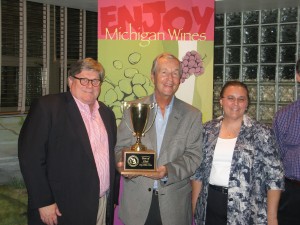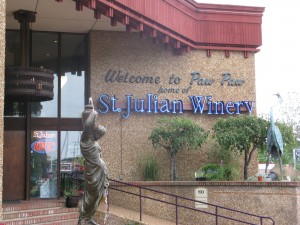Great Lakes Riesling Steps Onto The World Stage
Riesling originated in the Germany’s Rhine and Mosel valleys in the 1400’s. The grape is currently grown across the globe; South Africa has Cape Riesling, British Columbia has Okanagan Riesling and Bulgaria has Misket, a Riesling hybrid. Now there’s a new Riesling producer on the world stage: The Great Lakes region of the United States.
From the Leelanau Peninsula of Michigan to Ohio’s Grand Valley River, 2012 was perhaps the biggest Great Lakes Riesling harvest ever. No less than 39 wineries along Michigan’s Lake Michigan shoreline have at least one Riesling label.
Near Lake Erie in Ohio, Riesling can be found at no fewer than 31 wineries. The unusually warm summer allowed for an early harvest, but has not affected the quality of Riesling grapes. According to multiple sources across the Great Lakes region, 2012 is looking like a good year for Riesling.
To continue reading this post, you must either subscribe or login.[login_form][show_to accesslevel=”annual-membership” ]
Some of the first Great Lakes Riesling was planted by Ed O’Keefe of Chateau Grand Traverse around 1974. O’Keefe obtained his Riesling vines from Germany and that German influence lives on today in Northern Michigan.

Dan Matthies of Chateau Fontaine (center) at the 2012 Michigan Wine Competition with Chris Cook and Jamie Clover Adams
For Dan Matthies, owner of Chateau Fontaine Vineyards and Winery on Michigan’s Leelanau Peninsula, his German heritage is the driving force behind his dedication to Riesling. Chateau Fontaine’s two styles of Michigan Riesling, which are both estate grown, incorporate wine making philosophies used in Germany.
“We create the flavors on the vine,” Matthies says, “that way we don’t have to rely so much on sugar, that’s how the Germans do it.” Matthies methods seem to work. Chateau Fontaine Riesling has won 26 Gold medals at various wine competitions since 2001.
One version of Chateau Fontaine Riesling is a dry wine made with grapes that are harvested early. The other is a semi-sweet wine, with grapes that are usually harvested 3-4 weeks later. Matthies says that this second style is left on the vine longer so that the natural sugar level is balanced, and there is no need to add sugar later on in the winemaking process.
Across Lake Michigan’s Grand Traverse Bay on neighboring Old Mission Peninsula, Brys Estate Vineyard and Winery is making Riesling in three different styles; dry, sweet, and ice wine. Cooenraad Stasser, winemaker at Brys Estate, says he pays special attention to balancing the natural acidity of his Riesling. At Brys Estate,
Riesling is usually harvested at around 21.5 brix, with a pH of about 3.03 and titratable acidity at 9 g/L. Stasser ferments the dry wine to around 1.2% residual sugar to balance the 9 grams of acid. He says that their 2011 dry wine, which has white peach and apricot flavors, appeals to both dry and sweet drinkers. ‘It’s almost like biting into a white peach,” Stasser said. There are about seven acres of Riesling vines at Brys Estate, with the first vines planted in 2002. They are grafted onto 3309 rootstocks to provide resistance to soil pests. The grapes are grown on a Vertical Shoot Positioned (VSP) trellis system, with two cordons per vine, and 16 shoots per vine.
Stasser said this makes for about 28-30 clusters per vine, and a total of around four tons of fruit or more per acre. He also says that the Riesling vines that they grow are less susceptible to frost than the Pinot Gris, Cabernet Franc and Pinot Noir that they have in their vineyard.
Two hundred miles south of Brys Estate on the southwest shore of Lake Michigan, St. Julian Winery in Paw Paw, Michigan is also making Riesling. Nancie Corum-Oxley, winemaker at St. Julian, says that they make four varieties of wine from this grape: two are made under the Braganini Reserve label and two under the St. Julian label.  The different styles range from dry to a sweet late harvest. ‘With our warm days and cool nights during the harvest season, Riesling is the perfect grape to ripen nicely, yet retain its acid for a well-balanced wine in many styles,” Oxley says.
The different styles range from dry to a sweet late harvest. ‘With our warm days and cool nights during the harvest season, Riesling is the perfect grape to ripen nicely, yet retain its acid for a well-balanced wine in many styles,” Oxley says.
The grapes used to make St. Julian Riesling are grown in several area vineyards on both VSP and Scott Henry trellis systems. She also says that while growers use brix as a factor for determining harvest date, they also use acid and pH levels as well as flavors to make the decision.
St. Joseph Vineyard, located in the Grand Valley River region of Ohio, is making two varieties of Riesling wine. The first is a dry wine, with no residual sugar. The second is a semi-dry, with 1.5% residual sugar. Art Pietrzyk, winemaker at St. Joseph, says that their 20-year-old vines are grown on a VSP trellis, with 3309 rootstock. He says that their grapes develop flavors of green apple, mango, honeydew, and melon. The harvest usually occurs when the fruit reaches 23-24 brix, with a pH of around 3.05 and acid content at around 9.2 g/L. During the winemaking process, Pietrzyk uses a type of yeast from Scott Labs called CEG (Epernay II) which was first isolated at the Geisenheim Research Station in Germany. This yeast provides a slow fermentation at a temperature of 60F. St. Joseph’s Riesling also undergoes cold stabilization.
Homepage photo: Brys Estate Vineyard and Winery, Old Mission Peninsula, Michigan [wp_geo_map] [/show_to][password-recovery-link text=’Lost Password? Click here for password recovery.’]



Hi:
I loved your artical; however you did have one small error. Chateau Grand Traverse is “mid Michigan”, south of the 45th. Above the 45th is northern Michigan.
Cold tolerant vines south of the 45 and cold hardy varietal north of the 45th.
A whole new world of cold hardy vineyards and wines made from cold hardy varieties is being born in “Northern MIchigan”.
Thanks:
Jerry
I’d have to disagree with you Doc., as I imagine the vast majority of us so called “Mid-Michiganders”. Please visit us up here in Traverse City (or north of the 45th for that matter on the Leelanau) and proclaim this to be “Mid-Michigan”. And semantics aside, cold hardy and cold tolerant are interchangeable. One does not differentiate between both terms in relation to the 45th parallel (here in Northern Michigan, anyway). And to split hairs further, this are is generally referred to Northwest Michigan – please see michiganwines.com maps page.
Also, please consult a map. Chateau Grand Traverse is on Old Mission Peninsula, the most northern point of which essentially touches the 45th. Heading west the 45th parallel intersects the Leelanau Peninsula which is home to many wineries and vineyards – north and south of the 45th.
If the Upper Peninsula of Michigan growers (or growers north of Petoskey for that matter) want an AVA to call home, they need to approach our federal government and specify as such. I’m sure the fed. would have no problem allowing the term ‘Northern Michigan’ for the U.P.